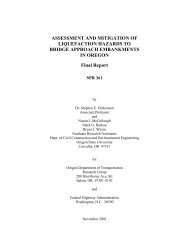Oregon Balance of State HIV/AIDS Housing & Services Systems ...
Oregon Balance of State HIV/AIDS Housing & Services Systems ...
Oregon Balance of State HIV/AIDS Housing & Services Systems ...
Create successful ePaper yourself
Turn your PDF publications into a flip-book with our unique Google optimized e-Paper software.
<strong>Oregon</strong> <strong>HIV</strong>/<strong>AIDS</strong> <strong>Housing</strong> and <strong>Services</strong> <strong>Systems</strong> Integration Plan—Appendices A-59<br />
provided to grantees through both a formula-based process for eligible metropolitan areas and urban counties<br />
and through a national competition for non-formula-eligible counties.<br />
EXTREMELY LOW-INCOME An individual or family whose income is between 0 and 30 percent <strong>of</strong> the median<br />
income for the area, as determined by the U.S. Department <strong>of</strong> <strong>Housing</strong> and Urban Development. (See Low-<br />
Income)<br />
FAIR HOUSING ACT The Federal Fair <strong>Housing</strong> Act prohibits, among other things, the owners <strong>of</strong> rental<br />
housing from discriminating against potential tenants based on race, sex, national origin, disability, or family<br />
size.<br />
FAIR MARKET RENT (FMR) Rents set by the U.S. Department <strong>of</strong> <strong>Housing</strong> and Urban Development (HUD) for<br />
a state, county, or urban area that define maximum allowable rents for HUD-funded subsidy programs. HUD<br />
calculates FMR to be at the 40 th percentile <strong>of</strong> recent moves, excluding apartments built within the past two<br />
years, meaning that 40 percent <strong>of</strong> recent movers paid less, and 60 percent paid more.<br />
FAMILY For purposes <strong>of</strong> the plan and local policy interpretation, and in keeping with HOPWA regulations,<br />
the term “family” encompasses nontraditional households, including families made up <strong>of</strong> unmarried domestic<br />
partners. A family is a self-defined group <strong>of</strong> people who may live together on a regular basis and who have a<br />
close, long-term, committed relationship and share responsibility for the common necessities <strong>of</strong> life. Family<br />
members may include adult partners, dependent elders, or children, as well as other people related by blood<br />
or marriage.<br />
FEDERAL EMERGENCY MANAGEMENT ADMINISTRATION (FEMA) An independent agency reporting to the<br />
President and tasked with responding to, planning for, recovering from, and mitigating disaster. FEMA<br />
administers the Emergency Food and Shelter Program as mandated by Title III <strong>of</strong> the McKinney-Vento Act.<br />
Also see McKinney-Vento Act.<br />
GROUP HOUSING/SHARED LIVING Two or more single adults, or families with children, sharing living<br />
arrangements in a house or an apartment. Generally, individuals each have a bedroom and share a kitchen,<br />
bath, and housekeeping responsibilities. The group facility may provide a limited range <strong>of</strong> services and be<br />
licensed or unlicensed.<br />
HAART Highly Active Anti-Retroviral Therapy. The preferred term for potent anti-<strong>HIV</strong> treatment. This<br />
means a combination <strong>of</strong> drugs (usually three or more) to combat <strong>HIV</strong>. Usually more than one class <strong>of</strong> drug is<br />
included in a HAART regimen. Includes protease inhibitors, and is <strong>of</strong>ten referred to as combination therapy<br />
or the “cocktail.” While it can be complicated to comply with, compliance to this regimen has dramatically<br />
extended the lives <strong>of</strong> people living with <strong>HIV</strong>/<strong>AIDS</strong>.<br />
HARM REDUCTION A set <strong>of</strong> practical strategies that reduce negative consequences <strong>of</strong> drug use, incorporating<br />
a spectrum <strong>of</strong> strategies for safer use, from managed use to abstinence. Harm reduction strategies meet drug<br />
users “where they’re at,” addressing conditions <strong>of</strong> use along with the use itself.<br />
<strong>HIV</strong> Human Immunodeficiency Virus. The virus that causes <strong>AIDS</strong>. <strong>HIV</strong> disease is characterized by a gradual<br />
deterioration <strong>of</strong> immune functions. During the course <strong>of</strong> infection, crucial immune cells, called CD4 T cells,<br />
are disabled and killed, and their numbers progressively decline. People infected with <strong>HIV</strong> may or may not<br />
feel or look sick.<br />
HOME HOME Investment Partnerships Program. Part <strong>of</strong> the Consolidated Plan process, this program is<br />
administered by the U.S. Department <strong>of</strong> <strong>Housing</strong> and Urban Development, and provides grants for lowincome<br />
housing through rental assistance, housing rehabilitation, and new construction.

















